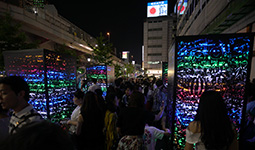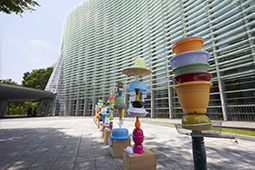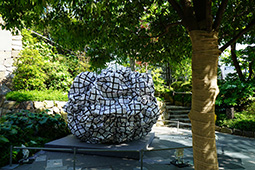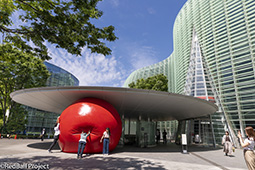Home > Highlighting JAPAN > Highlighting Japan September 2019 > Celebrating Diversity in Culture
Highlighting JAPAN


Art Colors the Roppongi Nightscape
Roppongi Art Night is an annual festival held in Tokyo’s Roppongi district, which is known for its art. Throughout the night, the streets of Roppongi are embellished with a variety of artworks, including installations, music, video works and more.
Held over two days on May 25 and 26, this year’s Roppongi Art Night was the 10th since the festival was first staged in March 2009. The main activities took place during the hours between sunset on day 1 and sunrise on day 2. What is the idea behind this all-night event? We asked Yoshinao Matsushima of Mori Building Co., Ltd., who has been involved in the planning and running of the event since its launch.
“Once, the main center for art in Tokyo has been in the Ueno district, which has a high concentration of museums and an art college. However, in the 2000s, three large art museums opened in Roppongi one after another. Roppongi Art Night seeks to enliven the area as a whole, around the nucleus of these three art museums,” says Matsushima.
The Mori Art Museum in the Roppongi Hills complex, the Suntory Museum of Art located in the Tokyo Midtown complex, and the National Art Center, Tokyo are known as the “Roppongi Art Triangle” and have each earned popularity among art fans both in Japan and overseas. Roppongi Art Night has been held by local authorities such as the Tokyo Metropolitan Government and Minato Ward, as well the local Roppongi Shopping District Association, and is supported by the Agency for Cultural Affairs.
Roppongi Art Night focuses on two themes: proposing a lifestyle that celebrates the enjoyment of art in our everyday lives, and creating a pioneering model for urban development in the metropolis of Tokyo.
“Japanese people were not really ones for nightlife,” says Matsushima. “For example, most people attending a concert would get on the train and go home when it ended at 9 p.m. At Roppongi Art Night, I would like people to experience a different way of enjoying Roppongi, strolling around the streets and eating out while viewing various kinds of art.”
At the 10th Roppongi Art Night held this year under the theme of “Night Journey, Daydream,” Choi Jeong Hwa, an artist active on the world stage, was the event’s first artist for it’s Main Program to be invited from overseas. His work Fruit Tree, in which vegetables and fruits are represented by colorful balloons, was exhibited in Roppongi Hills Arena. In addition to works by the main artist Choi, many other installations and performances with sound were staged lending color to the streets all across the Roppongi area. The number of works on display has increased from twenty-eight in the first exhibition to more than ninety this year, with some 800,000 people now attending the event.
“Not only has the scale of the event increased each year, but I get a real sense that the participating artists and those who view their works are now enjoying Roppongi Art Night in their own way. We are seeing a steady increase not only in the number of Japanese people but also foreign visitors, with many now bringing their families during the daytime hours to participate in workshops for children. Also, developments over the past ten years such as the opening of a number of contemporary art galleries in Roppongi have changed the look of the town itself,” says Matsushima.
Roppongi Art Night transcends existing art event formats, attracting a wider range of people and giving a boost to the community. With next year’s event scheduled to take place ahead of the Tokyo Olympics and Paralympics, the number of visitors from overseas is expected to increase even further. “We aim to stage an art festival that is even more successful in promoting the unique characteristics of Japan and Roppongi,” Matsushima says.
© 2009 Cabinet Office, Government of Japan










